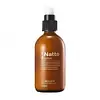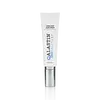What's inside
What's inside
 Key Ingredients
Key Ingredients

 Benefits
Benefits

 Concerns
Concerns

 Ingredients Side-by-side
Ingredients Side-by-side

Water
Skin ConditioningGlycerin
HumectantButylene Glycol
HumectantSqualane
EmollientHelianthus Annuus Seed Oil
EmollientPolyglyceryl-3 Methylglucose Distearate
Emulsifying1,2-Hexanediol
Skin ConditioningBacillus
Skin ConditioningGlyceryl Stearate
EmollientPEG-100 Stearate
Lithospermum Officinale Root Extract
Skin ConditioningPhenoxyethanol
PreservativeDimethicone
EmollientBacillus/Glutamic Acid Ferment Filtrate
Skin ConditioningPortulaca Oleracea Extract
Skin ConditioningPolyacrylate-13
Ethylhexylglycerin
Skin ConditioningXanthan Gum
EmulsifyingTocopheryl Acetate
AntioxidantSodium Polyglutamate
HumectantButyrospermum Parkii Butter
Skin ConditioningPolyisobutene
Palmitic Acid
EmollientPanthenol
Skin ConditioningCeramide NP
Skin ConditioningAllantoin
Skin ConditioningStearic Acid
CleansingScutellaria Baicalensis Root Extract
AstringentPolysorbate 20
EmulsifyingSorbitan Isostearate
EmulsifyingBeta-Glucan
Skin ConditioningAsiaticoside
AntioxidantBackhousia Citriodora Leaf Oil
MaskingEucalyptus Dives Leaf Oil
PerfumingMadecassic Acid
Skin ConditioningAsiatic Acid
Skin ConditioningFusanus Spicatus Wood Oil
MaskingLimonene
PerfumingCitral
PerfumingFarnesol
PerfumingWater, Glycerin, Butylene Glycol, Squalane, Helianthus Annuus Seed Oil, Polyglyceryl-3 Methylglucose Distearate, 1,2-Hexanediol, Bacillus, Glyceryl Stearate, PEG-100 Stearate, Lithospermum Officinale Root Extract, Phenoxyethanol, Dimethicone, Bacillus/Glutamic Acid Ferment Filtrate, Portulaca Oleracea Extract, Polyacrylate-13, Ethylhexylglycerin, Xanthan Gum, Tocopheryl Acetate, Sodium Polyglutamate, Butyrospermum Parkii Butter, Polyisobutene, Palmitic Acid, Panthenol, Ceramide NP, Allantoin, Stearic Acid, Scutellaria Baicalensis Root Extract, Polysorbate 20, Sorbitan Isostearate, Beta-Glucan, Asiaticoside, Backhousia Citriodora Leaf Oil, Eucalyptus Dives Leaf Oil, Madecassic Acid, Asiatic Acid, Fusanus Spicatus Wood Oil, Limonene, Citral, Farnesol
Water
Skin ConditioningCaprylic/Capric Triglyceride
MaskingGlycerin
HumectantCetearyl Alcohol
EmollientDimethicone
EmollientPalmitoyl Tripeptide-1
Skin ConditioningPalmitoyl Hexapeptide-12
Skin ConditioningCeramide NP
Skin ConditioningStearyl Glycyrrhetinate
Skin ConditioningTremella Fuciformis Sporocarp Extract
AntioxidantCamellia Sinensis Extract
AntioxidantHydroxymethoxyphenyl Decanone
Skin ConditioningPotassium Olivoyl Hydrolyzed Oat Protein
CleansingSqualane
EmollientDunaliella Salina Extract
Skin ConditioningZingiber Officinale Root Extract
MaskingTocopherol
AntioxidantHydrolyzed Jojoba Esters
Skin ConditioningBisabolol
MaskingBetaine
HumectantPanthenol
Skin ConditioningCeteareth-20
CleansingPolyisobutene
Glyceryl Oleate
EmollientGlyceryl Stearate
EmollientPolyglyceryl-10 Stearate
Skin ConditioningPolysorbate 20
EmulsifyingSorbitan Isostearate
EmulsifyingHydrogenated Lecithin
EmulsifyingPolyacrylate-13
Sucrose Stearate
EmollientXanthan Gum
EmulsifyingDisodium EDTA
Phenoxyethanol
PreservativePotassium Sorbate
PreservativeCaprylyl Glycol
EmollientBenzyl Alcohol
PerfumingCaprylhydroxamic Acid
Sodium Benzoate
MaskingEthylhexylglycerin
Skin ConditioningCitric Acid
BufferingWater, Caprylic/Capric Triglyceride, Glycerin, Cetearyl Alcohol, Dimethicone, Palmitoyl Tripeptide-1, Palmitoyl Hexapeptide-12, Ceramide NP, Stearyl Glycyrrhetinate, Tremella Fuciformis Sporocarp Extract, Camellia Sinensis Extract, Hydroxymethoxyphenyl Decanone, Potassium Olivoyl Hydrolyzed Oat Protein, Squalane, Dunaliella Salina Extract, Zingiber Officinale Root Extract, Tocopherol, Hydrolyzed Jojoba Esters, Bisabolol, Betaine, Panthenol, Ceteareth-20, Polyisobutene, Glyceryl Oleate, Glyceryl Stearate, Polyglyceryl-10 Stearate, Polysorbate 20, Sorbitan Isostearate, Hydrogenated Lecithin, Polyacrylate-13, Sucrose Stearate, Xanthan Gum, Disodium EDTA, Phenoxyethanol, Potassium Sorbate, Caprylyl Glycol, Benzyl Alcohol, Caprylhydroxamic Acid, Sodium Benzoate, Ethylhexylglycerin, Citric Acid
Ingredients Explained
These ingredients are found in both products.
Ingredients higher up in an ingredient list are typically present in a larger amount.
Ceramide NP is a type of ceramide and formally known as ceramide 3.
Ceramides are intercellular lipids naturally found in our skin that bonds dead skin cells together to create a barrier. They are known for their ability to hold water and thus are a great ingredient for dry skin.
Ceramides are an important building block for our skin barrier. A stronger barrier helps the skin look more firm and hydrated. By bolstering the skin ceramides act as a barrier against irritating ingredients. This can help with inflammation as well.
If you would like to eat ceramides, sweet potatoes contain a small amount.
Read more about other common types of ceramides here:
Ceramide AP
Ceramide EOP
Dimethicone is a type of synthetic silicone created from natural materials such as quartz.
What it does:
Dimethicone comes in different viscosities:
Depending on the viscosity, dimethicone has different properties.
Ingredients lists don't always show which type is used, so we recommend reaching out to the brand if you have questions about the viscosity.
This ingredient is unlikely to cause irritation because it does not get absorbed into skin. However, people with silicone allergies should be careful about using this ingredient.
Note: Dimethicone may contribute to pilling. This is because it is not oil or water soluble, so pilling may occur when layered with products. When mixed with heavy oils in a formula, the outcome is also quite greasy.
Learn more about DimethiconeEthylhexylglycerin (we can't pronounce this either) is commonly used as a preservative and skin softener. It is derived from glyceryl.
You might see Ethylhexylglycerin often paired with other preservatives such as phenoxyethanol. Ethylhexylglycerin has been found to increase the effectiveness of these other preservatives.
Glycerin is already naturally found in your skin. It helps moisturize and protect your skin.
A study from 2016 found glycerin to be more effective as a humectant than AHAs and hyaluronic acid.
As a humectant, it helps the skin stay hydrated by pulling moisture to your skin. The low molecular weight of glycerin allows it to pull moisture into the deeper layers of your skin.
Hydrated skin improves your skin barrier; Your skin barrier helps protect against irritants and bacteria.
Glycerin has also been found to have antimicrobial and antiviral properties. Due to these properties, glycerin is often used in wound and burn treatments.
In cosmetics, glycerin is usually derived from plants such as soybean or palm. However, it can also be sourced from animals, such as tallow or animal fat.
This ingredient is organic, colorless, odorless, and non-toxic.
Glycerin is the name for this ingredient in American English. British English uses Glycerol/Glycerine.
Learn more about GlycerinGlyceryl Stearate is a mix of glycerin and stearic acid.
It is used to stabilize the mixing of water and oil ingredients. By preventing these ingredients from separating, it can help elongate shelf life. It can also help thicken the product's texture.
As an emollient, it helps soften skin and supports barrier-replenishing ingredients.
In cosmetics, Glyceryl Stearate is often made from vegetable oils or synthetically produced.
This ingredient may not be fungal-acne safe
Fun fact: The human body also creates Glyceryl Stearate naturally.
Learn more about Glyceryl StearatePanthenol is a common ingredient that helps hydrate and soothe the skin. It is found naturally in our skin and hair.
There are two forms of panthenol: D and L.
D-panthenol is also known as dexpanthenol. Most cosmetics use dexpanthenol or a mixture of D and L-panthenol.
Panthenol is famous due to its ability to go deeper into the skin's layers. Using this ingredient has numerous pros (and no cons):
Like hyaluronic acid, panthenol is a humectant. Humectants are able to bind and hold large amounts of water to keep skin hydrated.
This ingredient works well for wound healing. It works by increasing tissue in the wound and helps close open wounds.
Once oxidized, panthenol converts to pantothenic acid. Panthothenic acid is found in all living cells.
This ingredient is also referred to as pro-vitamin B5.
Learn more about PanthenolPhenoxyethanol is a preservative that has germicide, antimicrobial, and aromatic properties. Studies show that phenoxyethanol can prevent microbial growth. By itself, it has a scent that is similar to that of a rose.
It's often used in formulations along with Caprylyl Glycol to preserve the shelf life of products.
Polyacrylate-13 is a type of acrylate polymer. Acrylate polymers are commonly used as adhesives in cosmetics.
Polyacrylate-13 creates a film to protect the skin. It is also used to thicken and stabilize a product. It works by making water a gel-like consistency. This gel consistency helps suspend particles.
Polyacrylate-13 is a copolymer of acrylic acid, acrylamide, sodium acrylate, sodium acryloyldimethyltaurate monomers
Learn more about Polyacrylate-13Polyisobutene is a synthetic polymer made from isobutene.
It is a film-forming agent and helps bind ingredients together.
Polyisobutene is not absorbed by the skin.
Learn more about PolyisobutenePolysorbate 20 is made by combining ethoxylation of sorbitan, ethylene oxide, and lauric acid. It is a mild cleansing agent, surfactant, and emulsifier.
As a surfactant, it helps collect dirt and oils for washing. Emulsifiers prevent oils and water from separating.
Polysorbate 20 also adds scent to a product. Since it is made using sorbitol, it has a sweet scent. Sorbitol can also be found in fruits such as apples and peaches.
The lauric acid used to create Polysorbate 20 is often derived from coconuts.
Polysorbate 20 may not be fungal acne safe.
Learn more about Polysorbate 20Sorbitan Isostearate is an emulsifer and cleaning agent. It is created from isostearic acid and sorbitol.
As an emulsifier, Sorbitan Isostearate prevents oils and water from separating.
Due to its isostearic acid base, it may not be safe for Malassezia or fungal acne.
Learn more about Sorbitan IsostearateSqualane is an emollient that helps the skin hold onto moisture. It's an oily liquid that occurs naturally in certain types of fish and plant oils.
Because squalane boosts hydration in the skin, it also comes with plenty of benefits: it is an antioxidant and can help fight free radicals and skin damage. Squalane is also found to have a detoxifying effect when applied.
Squalane comes from squalene, which occurs naturally within the sebum of our skin. It is one of the oils our skin produces to keep itself hydrated. Squalane is the hydrogenated version of squalene and has a longer shelf life.
Research shows that squalane is non-irritating (even at 100% concentration).
In general, it's a fantastic ingredient. It does a great job at hydrating the skin, and it's suitable for those with sensitive skin.
The source of squalane may impact malassezia / fungal acne. This is because olive oil derived squalane can contain impurities such as fatty acids and plant waxes. Sugarcane derived squalane is recommended for anyone with malassezia concerns.
Is squalane vegan?
This depends on the source. Squalane can be derived from both plants and animals. Most squalane used in skincare comes from plants.
Please note: the source of squalane is only known if disclosed by the brand. We recommend reaching out to the brand if you have any questions about their squalane.
Read more about squalene with an "e".
Is squalane an oil?
Squalane is often called an oil, but it’s technically not; it’s a hydrocarbon, meaning it’s only made of carbon and hydrogen, unlike true oils which are triglycerides made of fatty acids and glycerol.
The term “oil-free” isn’t regulated, so companies can define it however they want. Some exclude all oils, while others just avoid mineral oil or comedogenic oils.
While some people avoid oils thinking they cause breakouts, the right kind of oil (or oil-like ingredient like squalane) can actually help balance and hydrate your skin. It’s worth testing out simple oils or squalane to see what works best for your skin.
Learn more about SqualaneWater. It's the most common cosmetic ingredient of all. You'll usually see it at the top of ingredient lists, meaning that it makes up the largest part of the product.
So why is it so popular? Water most often acts as a solvent - this means that it helps dissolve other ingredients into the formulation.
You'll also recognize water as that liquid we all need to stay alive. If you see this, drink a glass of water. Stay hydrated!
Learn more about WaterXanthan gum is used as a stabilizer and thickener within cosmetic products. It helps give products a sticky, thick feeling - preventing them from being too runny.
On the technical side of things, xanthan gum is a polysaccharide - a combination consisting of multiple sugar molecules bonded together.
Xanthan gum is a pretty common and great ingredient. It is a natural, non-toxic, non-irritating ingredient that is also commonly used in food products.
Learn more about Xanthan Gum